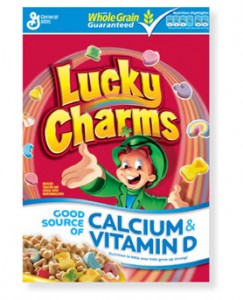Join Health Affairs for a virtual conversation between me and Angela Odoms-Young of Cornell University discussing the evolution of US food and nutrition policy, the current policy landscape, and thoughts on what lies ahead. It’s at 1:00 p.m. EDT. To join the Webinar, register here.
General Mills’ big news: less sugar!
My copy of Thursday’s New York Times business section has a full page ad from General Mills on page B3:
People are talking about sugar in kids’ cereals. General Mills is doing something about it. General Mills commits to reduce the sugar levels in advertised children’s cereals to single digit levels…Today our commitment to further lower sugar levels is among the most aggressive goals in the food industry. It’s a commitment we’re making in 130 countries around the world.
So that sounds good, no? But I wondered about two things: WHEN was this going to happen, and WHAT ELSE is in those cereals.
I went to the General Mills website and took a look at its gorgeous pages on “The Benefits of Cereal.” The site is beautifully illustrated with charts showing the changes in sugars per serving during the last couple of years. Take Lucky Charms, for example. In 2007, its sugar dropped from 12 to 11 grams per serving, and is now headed for “single digits.” By when? It doesn’t say.
General Mills’ press release boasts about all the whole grain its cereals contain:
General Mills’ 2005 whole grain initiative has been called one of the biggest health initiatives in the food industry. The company committed to ensuring that every Big G cereal would help deliver the benefits of whole grain. As a result, every Big G cereal now provides at least 8 grams of whole grain per serving, with many cereals providing 16 grams of whole grain or more.
Maybe, but what about the non-Big G kids cereals? Lucky Charms, for example again, has only one gram of fiber per serving, making it a low-fiber choice. It also has 190 mg sodium (half a gram of salt) per serving.
As for the banner on calcium and vitamin D: the cereal contains 10% of the Daily Value per serving, which goes up to 25% if you put milk on the cereal. As the cereal makers are always assuring me, the point of kids’ cereals (sweet, salty, low-fiber) is to get kids to drink milk.
All of this leads again to that philosophical question: does a reduction of one or two grams of sugars per serving make these cereals a GOOD choice for your kid? Does a little less sugar turn Lucky Charms into a health food? Is a time-insensitive commitment to reduce sugars a real commitment?
Is this action worth a full-page ad in the New York Times? General Mills must thing so. But why do I think this is more about marketing than about kids’ health?
You decide.

